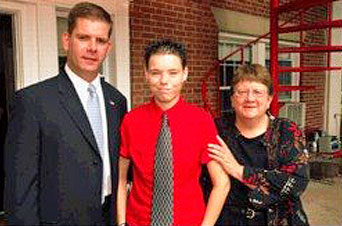 |
 |
Pro-family activism that makes a difference! | ||||
Massachusetts state education officials release directive to force transgenderism into all schools"Transgender" boys playing on girls' sports teams, using girls' locker rooms, name & pronoun changes, etc. POSTED: February 19, 2013 The "transgender agenda" onslaught is now hitting Massachusetts schoolchildren with full force. What you are about to read is nothing short of madness. But it is happening.
Massachusetts has begun forcing into the state's public schools the most thorough, invasive, and radical transgender initiative ever seen on a statewide level. Detailed in a document released on Friday, Feb. 15 by the Massachusetts Department of Elementary and Secondary Education (DESE), we outline its major points below.
Among other things, according to the document, schools must allow "transgender" children to play on sports teams and use the locker rooms, changing rooms, and restrooms of the opposite sex. And except with very young children, the schools will accept a child's decision to "become" the opposite sex, even without parents' knowledge or consent. A result of the recently passed "transgender rights" lawThis is a direct consequence of the passage of the recent "transgender rights and hate crimes" law (November 2011). In order to pass it more easily, the legislature had removed the "public accommodations" language to mollify those who were largely concerned about restrooms in stores and restaurants. (However, MassResistance had warned people that a major danger of the bill was the effect on public schools, which was being ignored by the "pro-family" establishment.) No person shall be excluded from or discriminated against in admission to a public school of any town, or in obtaining the advantages, privileges and courses of study of such public school on account of race, color, sex, gender identity, religion, national origin or sexual orientation. The DESE saw this as their opening to change the entire school system. Wheels started in motion last June with "Regulations"Although the law officially went into effect July 1, 2012, things started rolling even before that. In June, the State Board of Elementary and Secondary Education, which oversees the DESE, quietly released updates to its already onerous regulations governing anti-discrimination in the schools. These updates incorporated much of the basis of the DESE directive.
The mindset of the public officials doing thisAs shocking as this is, it reflects the radical nature of many of the people in the education establishment, not only in Massachusetts but around the country. What's included in the DESE document:
|
 |
Very confused. Young man at 2009 state-supported LGBT youth "prom" held each year in Boston City Hall. Part of annual "Youth Pride" day which attracts teenagers from across the state and promotes LGBT identities and behaviors to them. |
• How a child goes about "gender transition"
The guidelines present a radical transgender prescription, blandly referencing (possibly even recommending) dangerous hormone injections and body mutilations that can disfigure a person for the rest of his life, cause infertility, and do other long-term harm (not yet adequately studied).
Many, though not all, transgender youth undergo the experience of gender transition. The term "gender transition" describes the experience by which a person goes from living and identifying as one gender to living and identifying as another. For most youth, and for all young children, the experience of gender transition involves no medical intervention. Rather, most transgender youth will undergo gender transition through a process commonly referred to as "social transition," whereby they begin to live and identify as the gender consistent with their gender-related identity.
Some transgender youth who are close to reaching puberty, or after commencing puberty, may complement social transition with medical intervention that may include hormone suppressants, cross-gender hormone therapy, and, for a small number of young people, a range of gender-confirming surgeries. The decision about whether and how to undergo gender transition is personal and depends on the unique circumstances of each individual. There is no threshold medical or mental health diagnosis or treatment requirement that any student must meet in order to have his or her gender identity recognized and respected by a school.
Furthermore, people with these body changes have been shown to have a much higher than average incidence of other health problems and psychological dysfunction (including suicide). However, the DESE makes no mention of any health hazards.
• The school's role in changing the student's name -- and using a different pronoun
This is like something out of science fiction. The guidelines say that if a male student decides to use a girl's first name, or vice versa, then the school is required to use the student's "chosen" name and pronoun ("he" or "she") -- no matter how young the student -- and also update all of the school's records with the new name and pronoun.
[W]hen requested, schools should accurately record the student's chosen name on all records . . . In sum, school personnel should use the student's chosen name and pronouns appropriate to a student's gender identity, regardless of the student's assigned birth sex.
. . . If the student has previously been known at school or in school records by his or her birth name, the principal should direct school personnel to use the student's chosen name. Every effort should be made to update student records (for example, Individualized Education Programs) with the student's chosen name and not circulate records with the student's assigned birth name.
Parents can be kept out of the loop if the student is not a "young student":
. . . decisions should be made in consultation with the student, or in the case of a young student, the student's parent or guardian. The key question is whether and how sharing the information will benefit the student.
In other words, the parent can be left out of the decision of what "will benefit the student." Note also that "young" is not defined, leaving much leeway for the school.
Celebrating transgender children. Barbara Walters poses with a 10-year-old boy who "identifies" and dresses as a girl, in 2007 ABC 20/20 Special. Heavy propaganda attempting to legitimize outrageous concept of transgender children. (Article and show titled "Born with the wrong body" and "My secret self.") |
|
• Using opposite-sex restrooms, locker rooms, and changing facilities
The guidelines and regulations clearly instruct schools not to segregate any facilities by "birth sex." To do anything different would constitute "denying access" to these students, the guidelines say.
In all cases, the principal should be clear with the student (and parent) that the student may access the restroom, locker room, and changing facility that corresponds to the student's gender identity.
In addition, if the "transgender" student requests, the school is required to provide a single "unisex" restroom or changing room for the student's use.
• Participating in opposite-sex athletic teams and activities
The guidelines (and regulations) instruct that schools must allow boys who claim to be girls play on girls' sports teams, and vice versa. As outlined above, the student's self-labeled "gender identity" is the determining factor, not the "assigned sex at birth." (This latter phrase is absurd, since scientifically speaking a person's biological sex never changes.)
Where there are sex-segregated classes or athletic activities, including intramural and interscholastic athletics, all students must be allowed to participate in a manner consistent with their gender identity.
It even gives an example that that a boy who claims to be a girl must be allowed to be part of a girls' cheerleading squad, use their locker room, and participate in the girls' regional cheerleading competitions (and travel with them) if he desires.
• Removing the concept of "gender" / biological sex from all school life
The guidelines again draw on radical "queer theory" (and feminist) concepts. Schools are instructed to remove all possible differentiation between the sexes throughout all student life -- distinctions which have been in place since the beginning of time -- because now such distinctions can be harmful.
As a general matter, schools should evaluate all gender-based policies, rules, and practices . . . Gender-based policies, rules, and practices can have the effect of marginalizing, stigmatizing, and excluding students, whether they are gender nonconforming or not. . . . For example, some schools require students to wear gender-based garb for graduation or have gender-based dress codes for prom, special events, and daily attire. Schools should eliminate gendered policies and practices such as these. For example, one school that previously had blue graduation gowns for boys and white ones for girls switched to blue gowns for all graduates. The school also changed its gender-based dress code for the National Honor Society ceremony, which had required girls to wear dresses.
Similarly, some classroom teachers may routinely include gender-based practices in the classroom. For example, some [elementary school] teachers may have boys and girls line up separately to leave the classroom to go to lunch, the gymnasium, restrooms, or recess, and may never have considered the educational value of non-gendered alternatives, such as having students line up in the order of their birthdays, or alphabetically by name, or in the order in which they are sitting.
• Transgender diversity training for children and school staff
In the interest of "safety," schools are instructed to hold transgender diversity training sessions for all students and school staff. As we've warned people, the recent anti-bullying requirements are now being used for this purpose.
In order to further a safe and supportive school environment for all students, schools should incorporate education and training about transgender and gender nonconforming students into their anti-bullying curriculum, student leadership trainings, and staff professional development.
The guidelines list a variety of "queer theory" topics to be included for school staff training, including the use of "gender neutral language and practices."
Professional development for school staff could include topics on gender identity and gender nonconformity such as . . . key terms related to gender identity and expression; the development of gender identity; the experiences of transgender and other gender nonconforming students; risk and resilience data regarding transgender and gender nonconforming students; ways to support transgender students and to improve the school climate for gender nonconforming students; gender-neutral language and practices; and this guidance.
• No tolerance for other students' discomfort with transgenderism
The directive is clear that there is to be no tolerance for students who become uncomfortable or upset at these situations being pushed on them. The school's approach is to be unyielding to any such discomfort, and to re-educate those students to have more "acceptable" reactions and values.
Some students may feel uncomfortable with a transgender student using the same sex-segregated restroom, locker room or changing facility. This discomfort is not a reason to deny access to the transgender student. School administrators and counseling staff should work with students to address the discomfort and to foster understanding of gender identity, to create a school culture that respects and values all students.
This is also where the "anti-bullying" law will play out. As the Massachusetts anti-bullying law was written (much of it in collaboration with homosexual-transgender groups), any outwardly negative reaction against transgenderism can now be considered bullying, and subject to discipline and punishment.
In fact, it is completely natural for a child to feel very uncomfortable using a female name for an individual they know to be male, or seeing a boy in girl's clothing, or to believe it's unfair that a boy is competing athletically as a girl, etc. These reactions are now considered by the school to be backwards and disruptive. In other words, the phrase "respects and values all students" only goes in one direction (protecting only a tiny, sadly disturbed minority).
• Informing families and the school community of the necessity for these steps
Finally, the guidelines encourage schools to communicate with families and others that all of this radical change is "a legal obligation" that is in the best interests of everyone.
Superintendents and principals need to review existing policies, handbooks, and other written materials to ensure that they are updated to reflect the inclusion of gender identity in the student antidiscrimination law, and may wish to inform all members of the school community, including school personnel, students, and families, of the recent change to state law and its implications for school policy and practice. This could take the form of a letter that states the school's commitment to being a supportive, inclusive environment for all students, as well as the school's legal obligation to provide equal educational opportunities for all students.
Misleading "mandate" being forced on schools
Is all this really a legal obligation? The DESE document and the recent news stories discussing it are extremely misleading. As discussed above, it appears that the only "legal obligation" of the schools is to follow the rather vague text of the statute not to "discriminate" in "advantages, privileges and courses of study." Almost all of the rest of these radical directives and requirements, including the DESE's regulations, are not technically part of the law, but were created by the education officials and the State Board of Elementary and Secondary Education in collaboration with LGBT activists (as acknowledged in the DESE document).
But from what we've seen so far, this entire package is being forced on the schools at breakneck speed, with no obvious choice given to any school district. And sadly, most school boards are dominated by sympathizers with no interest in challenging it.
COMING UP: The Transgender Law Signing at the State House, Jan. 2012: Getting it started: The scene at the State House, several weeks after the transgender rights law was passed, activists converged for the signing ceremony by the Governor and bragged about what they were going to accomplish.
ALSO COMING UP: "Is there such a thing as transgender children?"
Take action: What you can do!
These horrible things happen -- and continue -- because not enough people confront their public officials.
1. CONTACT THE STATE BOARD OF EDUCATION:
These are the people who created the new regulations and oversee the DESE. If you are serious about this, they MUST hear from you.
State Board of Elementary and Secondary Education members
Contact page
Massachusetts Board of Elementary and Secondary Education
75 Pleasant Street
Malden, MA 02148
Phone: 781-338-3102
Fax: 781-338-3770
E-mail: boe@doe.mass.edu or use their contact form
(MassResistance going to request a meeting with the State Board.)
2. Here are the legislators who voted for this horrible law in 2011.
Let them know how you feel about their vote!
3. Help MassResistance lobby for bill to repeal transgender law!
One of the strong pro-family bills that MassResistance is supporting is Bill HD 1223, filed by Reps. Jim Lyons and Marc Lombardo. This bill would completely repeal the transgender law. We will be giving you more information on how you can help us get this passed. If you want to be active in this, let us know!
| Top |


